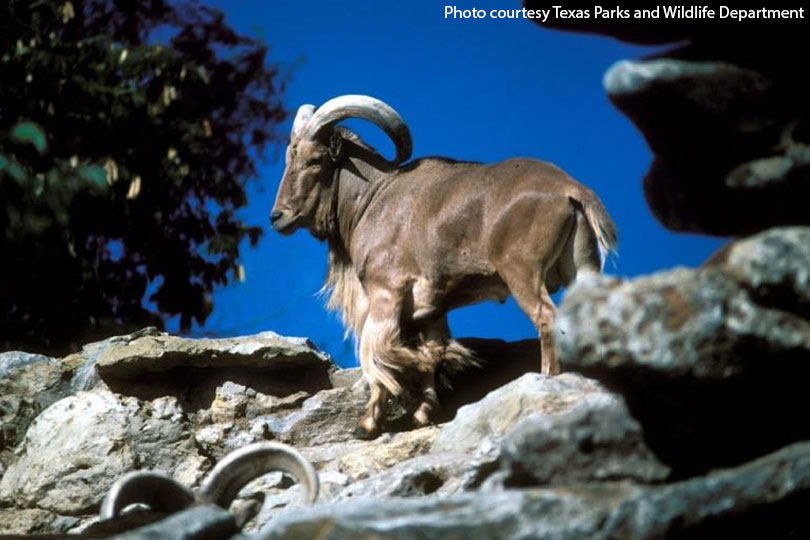By Jessica Domel
Multimedia Reporter
As the number of aoudad in Far West Texas continues to grow, and the population of mule deer declines, the Texas Parks and Wildlife Department (TPWD), Sul Ross State University’s Borderlands Research Institute (BRI) and other partners are working with landowners to study the impact these exotic sheep may have on native mule deer.
The multi-year, multi-partner project is underway now in the Quitman and Chinati mountains.
“Aoudad have become so numerous in the habitats that bighorn sheep and mule deer occupy. We’re really concerned with competition amongst all three species, but we don’t have a good coexisting population of bighorn and aoudad to look at,” Justin French, BRI big game specialist, said. “We’ve got 40 of each species GPS-collared in each of the two mountain ranges, and we’re looking at the ways they interact when we don’t disturb anything.”
Over the next four years, TPWD and BRI will gather the data from the GPS collars and will work with partners at Texas Tech University and Texas A&M-Kingsville to analyze the data so we can better understand how the species interact and impact one another.
Aoudad, or barbary sheep, are native to the rocky, arid mountain ranges in North Africa.
They were first brought to Texas in the 1950s to provide additional hunting opportunities, and since then, their population has continued to grow.
The sheep eat some grass, shrubs and forbs and can compete with native wildlife for resources.
“When you have high numbers of aoudad, and it’s really dry, and they have a big impact on a browse resource, they can actually facilitate good browse plants dying,” Shawn Gray, TPWD mule deer and pronghorn program leader, said. “There could be over-utilization of the browse resource, and that’s bad for mule deer. The desert ecosystem is so fragile. We’re not supposed to have thousands and thousands of animals on them long-term.”
Over the years, drought, habitat degradation, predators and other factors have weighed on mule deer populations in the Trans-Pecos and Panhandle.
During times of drought, there are fewer forbs on the landscape for mule deer to eat. There also tends to be less ground cover to hide fawns, leaving them susceptible to predation by coyotes and mountain lions.
The mule deer population in the Trans-Pecos dropped from around 170,000 in 2005 to 152,870 in 2017 and to 120,000 in 2022.
While mule deer populations have fallen, aoudad are thriving.
“As those populations (of aoudad) get bigger, they have to spread out and start finding different resources. They can’t all use the very best habitat. When that happens, those aoudad start using areas that are more mule deer habitat. That’s where the competition’s actually happening. It’s a secondary habitat for aoudad, but primary habitat for mule deer,” French told the Texas Farm Bureau Radio Network.
One of the goals of the project is to quantify how many aoudad the desert environment in Texas can support without negatively impacting mule deer and bighorn sheep.
“Regardless of how people feel about aoudad, the fact of the matter is they’re here to stay, and they have to be managed,” French said. “The problem is that we don’t have enough information to know what appropriate management looks like. So, this is really the first step at a balanced solution.”
Researchers will also look at the reproductive capacity of aoudad.
“That’s not been studied yet, believe it or not,” French said. “So, lambing studies are on our radar. We need to understand how they reproduce and when they reproduce. We see evidence that it’s twice a year, and they often twin. We need to have hard numbers for that.”
Another part of the research project involves a reduction in aoudad numbers.
“We’ll actually remove a large number of aoudad and look at how the interactions that we see change,” French said.
Gray said the information gathered through the multi-year research project will help the department and landowners better understand what’s needed for sound aoudad management and how that can help our native mule deer and bighorn sheep need to thrive.

